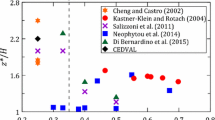Abstract
Using experimental data obtained in naturally grown boundary layers over a generic urban-type roughness (height h) it is shown that the surface drag is strongly dependent on the flow direction with respect to the roughness orientation. The variations with wind direction are accompanied by corresponding changes in the parameters contained in the usual logarithmic description of the flow in the near-wall inertial layer, \({U/u_\tau=\frac{1}{\kappa}\ln[(z-d)/z_{\rm o}]}\), principally the roughness length z o, which can vary by a factor of around three. The maximum surface drag (and roughness length) occur when the flow direction is at an angle around 45° to the faces of the cubical roughness elements, consistent with the known fact that the drag of an isolated cube in a thick boundary layer is much larger at that orientation than for flow directions normal to the faces. An accurate electronic balance was used to determine the surface drag (and hence friction velocity u τ ) and pressure-tapped roughness elements allowed estimation of the zero plane displacement d. It is shown that the best logarithmic-law fits then generally require values of the von Kármán ‘constant’ κ significantly lower than its classical value of around 0.41. For a factor of six increase in the Reynolds number (from \({U_{\rm ref}h/\nu\approx 3,500}\)), Reynolds number effects are shown to be very weak and, coupled with the form drag and total drag data, the results thus suggest that frictional contributions to the total surface drag are relatively small.
Similar content being viewed by others
References
Adrian RJ (2005) Twenty years of particle image velocimetry. Exp Fluids 39: 159–169
Andreas E, Claffey K, Jordan R, Fairall CW, Guest P, Persson C, Grachev A (2006) Evaluations of the von Kármán constant in the atmospheric surface layer. J Fluid Mech 559: 117–149
Castro IP, Robins AG (1977) The flow around a surface-mounted cube in uniform and turbulent streams. J Fluid Mech 79: 307–335
Cheng H, Castro IP (2002) Near-wall flow over urban-like roughness. Boundary-Layer Meteorol 104: 229–259
Cheng H, Hayden P, Robins AG, Castro IP (2007) Flow over cubes of different packing densities. J Wind Eng Ind Aerodyn 95: 715–740
Claus J (2011) Wind direction effects on urban flows. PhD thesis, Engineering Sciences, University of Southampton
Claus J, Coceal O, Thomas TG, Branford S, Belcher SE, Castro IP (2012) Wind direction effects on urban flows. Boundary-Layer Meteorol 142: 265–287
Coceal O, Thomas TG, Castro IP, Belcher SE (2006) Mean flow and turbulence statistics over groups of urban-like cubical obstacles. Boundary-Layer Meteorol 121: 491–519
Hagishima A, Tanimoto J, Nagayama K, Meno S (2009) Aerodynamic parameters of regular arrays of rectangular blocks with various geometries. Boundary-Layer Meteorol 132: 315–337
Hayden P, Mapurisa T, Robins AG (2007) Spanwise variation of drag on roughness elements in a nominally two-dimensional boundary layer. In: Aubrun S (ed) Proceedings of the international workshop on physical modelling of flow and dispersion, Presses Universitaires d’Orleans, Orleans, France, pp 87–91. ISBN: 2-913454-32-1
Iyengar A, Farell C (2001) Experimental issues in atmospheric boundary layer simulations: roughness length and integral length scale determination. J Wind Eng Ind Aerodyn 89: 1059–1080
Jackson PS (1981) On the displacement height in the logarithmic velocity profile. J Fluid Mech 111: 15–25
Krogstad P-Å, Efros V (2010) Rough wall skin friction measurements using a high resolution surface balance. Int J Heat Fluid Flow 31: 429–433
Krogstad P-Å, Antonia RA, Browne LWB (1992) Comparison between rough- and smooth-wall turbulent boundary layers. J Fluid Mech 245: 599–617
Lee J, Seena A, Lee SH, Sung H (2012) Turbulent boundary layers over rod- and cube-roughneded walls. J Fluid Mech (under review)
Leonardi S, Castro IP (2010) Channel flow over large cube roughness: a DNS study. J Fluid Mech 651: 519–539
Lim HC, Castro IP, Hoxey RP (2007) Bluff bodies in deep turbulent boundary layers: Reynolds number issues. J Fluid Mech 571: 97–118
Maruyama T (1993) Optimization of roughness parameters for staggered arrayed cubic blocks using experimental data. J Wind Eng Ind Aerodyn 46–47: 165–171
Meunier P, Leweke T (2003) Analysis and treatment of errors due to high velocity gradients in particle image velocimetry. Exp Fluids 35: 408–421
Nagib H, Chauhan K (2008) Variations of von Kármán coefficient in canonical flows. Phys Fluids 20: 101518
Perry AE, Schofield WH, Joubert PN (1969) Rough wall turbulent boundary layers. J Fluid Mech 37: 283–413
Reynolds RT, Hayden P, Castro IP, Robins AG (2007) Spanwise variations in nominally two-dimensional rough-wall boundary layers. Exp Fluids 42: 311–320
Author information
Authors and Affiliations
Corresponding author
Rights and permissions
About this article
Cite this article
Claus, J., Krogstad, PÅ. & Castro, I.P. Some Measurements of Surface Drag in Urban-Type Boundary Layers at Various Wind Angles. Boundary-Layer Meteorol 145, 407–422 (2012). https://doi.org/10.1007/s10546-012-9736-3
Received:
Accepted:
Published:
Issue Date:
DOI: https://doi.org/10.1007/s10546-012-9736-3




